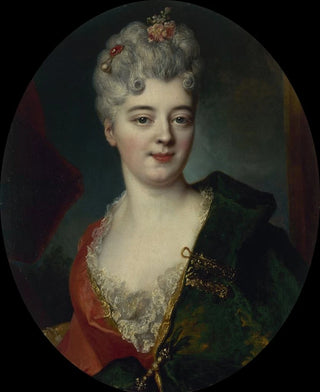Art print | Presumed portrait of Elisabeth Delpech, Marquise de Cailly - Nicolas de Largillière


View from behind

Frame (optional)
The "Art print presumed portrait of Elisabeth Delpech marquise de Cailly" by Nicolas de Largillière is an iconic work from the 18th century, showcasing the elegance and refinement of French painting of that era. This piece goes beyond a simple representation; it embodies a true ode to female beauty and nobility. Through the delicate features of the marquise, Largillière manages to capture the very essence of his subject, blending technical virtuosity with artistic sensitivity. The composition, imbued with grace, invites the viewer to immerse themselves in a universe where art and life intertwine harmoniously.
Style and uniqueness of the work
Largillière's style stands out for its realistic approach, while maintaining a certain idealization of figures. In this portrait, the marquise is depicted with natural elegance, her sumptuous clothing and graceful posture emphasizing her aristocratic status. The color palette chosen by the artist, subtly nuanced, evokes an atmosphere of serenity and sophistication. The meticulous details, such as the light reflections on fabrics and the delicate textures of the skin, testify to undeniable technical mastery. This artwork, beyond its decorative function, aims to be a symbol of the social and cultural identity of its time, where fashion and social status were closely intertwined.
The artist and his influence
Nicolas de Largillière, a major figure in 18th-century portraiture, distinguished himself through his exceptional talent and keen sense of observation. Trained at the Flemish school, he integrated Italian and French influences to develop a unique style that is entirely his own. His portraits, often commissioned by high aristocracy, reflect an era when art became a means of asserting social position. Largillière captured the spirit of his time, transforming his models into icons of their class. His influence endures, inspiring many artists who succeeded him, while continuing to fascinate art enthusiasts with his innovative approach.

Matte finish

View from behind

Frame (optional)
The "Art print presumed portrait of Elisabeth Delpech marquise de Cailly" by Nicolas de Largillière is an iconic work from the 18th century, showcasing the elegance and refinement of French painting of that era. This piece goes beyond a simple representation; it embodies a true ode to female beauty and nobility. Through the delicate features of the marquise, Largillière manages to capture the very essence of his subject, blending technical virtuosity with artistic sensitivity. The composition, imbued with grace, invites the viewer to immerse themselves in a universe where art and life intertwine harmoniously.
Style and uniqueness of the work
Largillière's style stands out for its realistic approach, while maintaining a certain idealization of figures. In this portrait, the marquise is depicted with natural elegance, her sumptuous clothing and graceful posture emphasizing her aristocratic status. The color palette chosen by the artist, subtly nuanced, evokes an atmosphere of serenity and sophistication. The meticulous details, such as the light reflections on fabrics and the delicate textures of the skin, testify to undeniable technical mastery. This artwork, beyond its decorative function, aims to be a symbol of the social and cultural identity of its time, where fashion and social status were closely intertwined.
The artist and his influence
Nicolas de Largillière, a major figure in 18th-century portraiture, distinguished himself through his exceptional talent and keen sense of observation. Trained at the Flemish school, he integrated Italian and French influences to develop a unique style that is entirely his own. His portraits, often commissioned by high aristocracy, reflect an era when art became a means of asserting social position. Largillière captured the spirit of his time, transforming his models into icons of their class. His influence endures, inspiring many artists who succeeded him, while continuing to fascinate art enthusiasts with his innovative approach.






